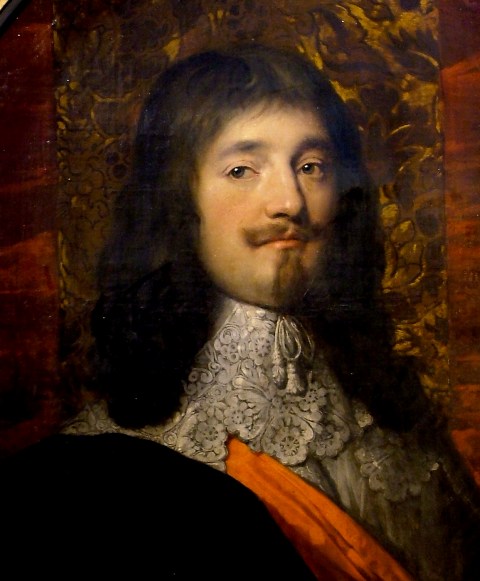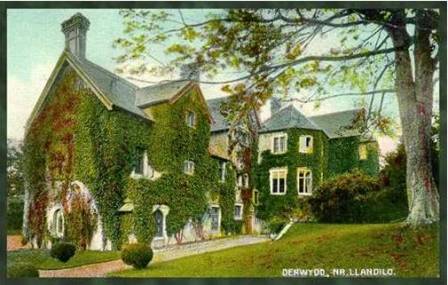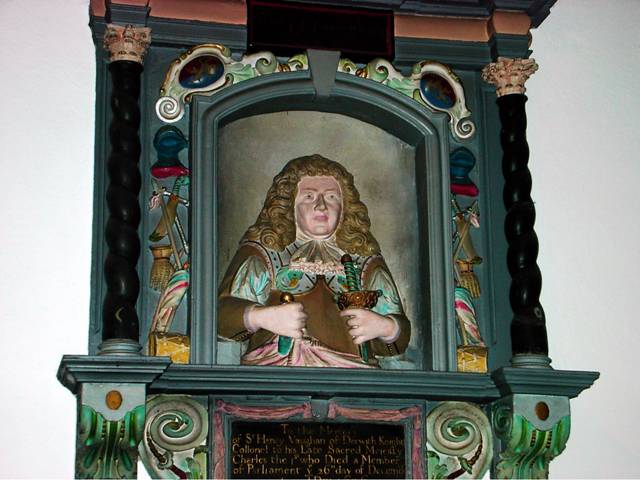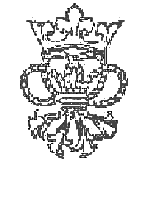Sir Henry Vaughans - a Royalist company of the Sealed Knot.
Sir Henry Vaughan of Derwydd, near Llandeilo, Carmarthenshire, was a younger brother of the First Earl of Carbery, John Vaughan of Golden Grove. By the time of the Civil War, the Vaughan's of Golden Grove were the dominant landowner in Carmarthenshire. Henry's nephew, Richard Vaughan had inherited the earldom in 1634, and soon after the outbreak of the Civil war Richard was appointed the Kings Lieutenant General in South Wales.

Richard Vaughan, 2nd Earl of Carbery Sir Henry Vaughan's Nephew:
Carmarthenshire County Museum Abergwili

Derwydd House, Llandybie, Carmarthenshire
Raising troops in the seventeenth century was often a family affair, and Henry Vaughan undertook to raise a regiment of foot to serve under his nephew's overall command. In October and November 1642, the Vaughans seized the Arms of the Trained Bands of the County of Carmarthen, and levied 15 shillings from each of the Trained bands members to finance the raising of a regiment of foot.(1)

 "Sir John Byron :
Dobson c1643"
"Sir John Byron :
Dobson c1643"
(3) Mercurius Aulicus/National Portriat Gallery
(4)DNB Sir Henry Vaughan
On 26 October, 1643, Sir Henry was raised to the rank of Sergeant Major General, and sent back to serve in West Wales, suppressing the rebel forces in Pembrokeshire, and raising fresh forces to serve with the Oxford Army(5). The bulk of the Regiment remained with the Oxford Army under Sir Henry Vaughan's son, (also a Henry Vaughan). Although the Welsh levies at Edgehill were reported to be badly equipped, the troops raised in the next few months not only had access to the substantial Trained bands stores, but also the products of the Iron Foundry on Sir Henry's land at Llandyfan(6). Also, in March 1643, Vaughans men moved to secure a second Iron works at., Llangyndeirne, which later grew into the steel town of Llanelli(7).
(6) The Cannonballs of Llandyfan Forge (Ellyn Francis)
(7)Anon-The Earle of Carberyes pedegree Wing E71 57 E 355 29 -p1to5
In March 1643/4, Parliament's Navy landed strong forces in Pembrokeshire to support the local rebels, and Sir Henry was forced to vacate Haverfordwest somewhat precipitously, leaving behind a consignment of 'a hundred red coats which were never worn'. This misfortune for the Royalist cause is the reenactor's gain, for thereby we know that Sir Henry's Regiment were dressed in red coats(8).
The Bulwark , Carmarthen
Sir Henry then fell back on Carmarthen town, which the Vaughans had fortified on the advice of a professional engineer named Captain Richard Steele. A substantial length of the earthworks remains, built to a contemporary specification and standing on land contributed from the estate of Sir Henry Vaughan, still is visible today(9) even though masked from public view by the vandalistic edifice of the local Tesco Stores. Recent archaeological work has also shown that the towers of the Medieval Castle, which formed part of the circuit, were modified to mount cannon to command the Bridge over the river Towy(10) After a fierce assault on the Gate at nearby Lammas Street, Sir Henry was forced to retreat from Carmarthen Town for a while but it was back in Royalist control the next year.
By then Sir Henry had returned to the Oxford Army, where his Regiment served as part of Lisle's Tertio, initally at Reading Garrison, and later at Cheriton , the Lostwithiel Campaign and Second Newbury. On 26 April, part of the regiment, under command of Henry Vaughan the younger, was attacked at Bampton in the Bush, 18 miles west of Oxford, by Oliver Cromwell. Cromwell wrote,
The enemy presently barricadoed up the town; got a pretty strong house. My body came up about eleven in the night, I sent a summons. They slighted it; I put myself in a posture that they could not escape me, hoping to deal with them in the morning. my men charged them up to the barricades in the night, but truly they were of so good resolution that we could not force them from it, and indeed they killed some of my horse , and I was forced to wait until the morning.'(11)
'Mercurius Aulicus', the Royalist newsletter, presents the other side of the story:
'next night (Cromwell) crept back again, fell upon another Quarter, took and scattered some Horse (most of whom have since found their way home) whereby he surprised some of Col.Lisle's musketeers, who for present were forced to get into a countryhouse at Bampton, which he presently surrounded, but must not have approached if either that house had been fit for soldiers , or these soldiers had ammunition.(12)
Despite their sturdy defence, it seems that the next morning, these isolated soldiers surrendered, perhaps due to lack of powder and shot after the night attacks, and perhaps 200 of them were taken prisoner.(11),(13)
Although the regiment itself does not appear to have taken part in the battle of Naseby, Sir Henry himself was wounded in the fight and made prisoner. He was one of the Royalist prisoners in the Tower, commemorated by his fellow prisoner, Sir Francis Wortley in these words:
"Sir Harry Vaughan looks as grave
As any beard can make him,
Those ('who,) came poore prisoners to see
Do for our Patriarke take him,
Old Harry is a right true blue,
As valiant as Pendraggon,
And would be loyal to his king
Had King Charles ne'er a rag on."(14)
Henry Vaughan the younger presumably took part in the Skirmish at Llandeilo in April 1648 where the Royalist Insurgents defeated elements of the New Model Army, no less a person than the Agitant General of the New Model, Colonel Fleming, being killed in the process(15). A month later, he was made prisoner together with 48 of his men while trying to cross Snowdonia to join Sir John Owens force's, and was then confined to Denbigh Castle, this marking the end of the Civil War career of the Vaughans(16)
(16) Civil war in North Wales - Norman Tucker
Among near kinsmen and neighbours who had served under Sir Henry's command, were his sons, Lieutenant-Colonel Henry Vaughan and Walter Vaughan, his son-in-law, Ensign Morgan Owen of Glasallt, Ensign Rice Prichard of Llandovery, and Francis Jones of Tregib near Llandeilo. Sir Henry the elder was released from prison by Parliament in 1659, and he died shortly before 5 January 1660/1.(17)
There is a portrait of 'Sir Henry Vaughan of Derwydd' although in our opinion, from the date of the costume depicted it is a likeness of his son, the Lieutenant Colonel of the regiment, who succeeded to the knighthood. Sir Henry the younger perished falling from his horse on Christmas Day 1676.(18)
 (18) Monument to Sir Henry Vaughan the Younger, Llandybie Church,
Carmarthenshire
(18) Monument to Sir Henry Vaughan the Younger, Llandybie Church,
CarmarthenshireAt the end of
the 2005 season, we were granted permission by Lord General
Westwood to raise fresh troops for the Royalist Cause,
and at the battle of Nantwich 2006 we were pleased to fight
alongside the Earl of Northampton's Regiment for the
first time. We will be concentrating on developing our
membership in the historical heartland of Vaughan's
Regiment in the South Western Portion of Wales, and we
shall be attached to Northampton's regiment while we
try to grow our numbers. We look forward to the growth
of our new company, under the wing of one of the oldest
regiments in the Society, with its own strong Welsh
Connections to boost the field strength of Prince
Rupert's Tertio in the coming years.
Based on an article first published in 'The Northampton Intelligencer', the Journal of the Earl of Northamptons Regiment of the Sealed Knot Society

Sealed Knot Society
For Details contact
K Jarvis

Get away from the Twenty First Century with the
Bron Haul, Penlan Road ,
Carmarthen, SA 31 1DN
07929 870885
Contact us at


- Click this Flag
- to find out more about Sir Henry Vaughans
or come to our next display and speak to any of our members

- Click this Flag
- to find out more about our host regiment, The Earl of Northamptons